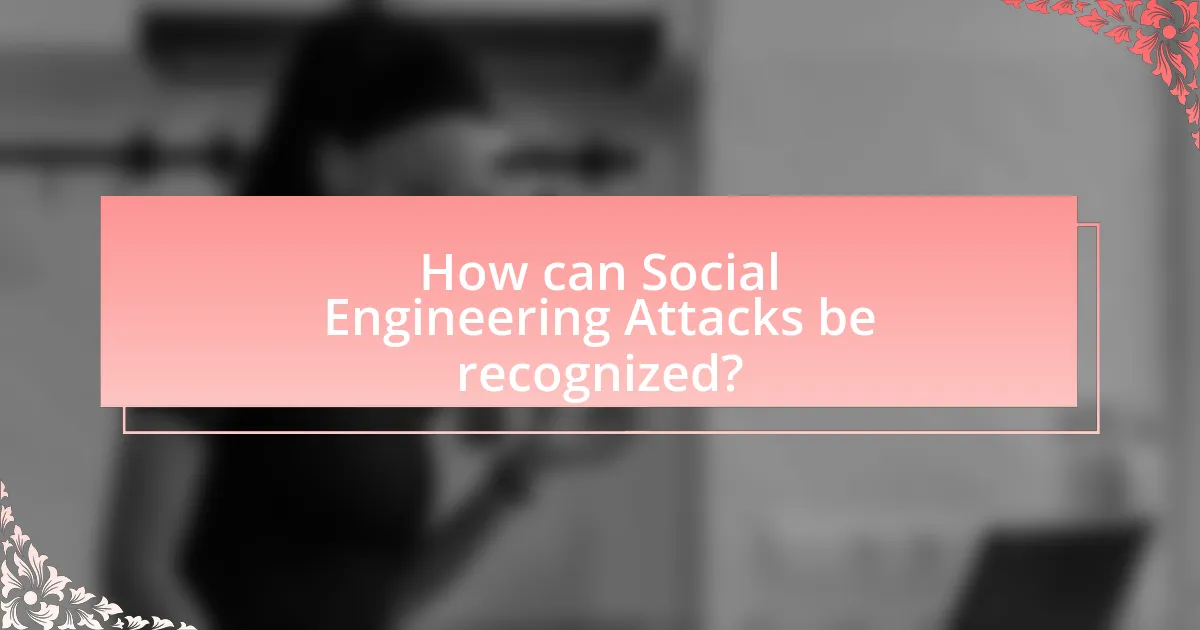Social engineering attacks are manipulative tactics employed by cybercriminals to deceive individuals into revealing confidential information or taking actions that compromise security. This article outlines the various techniques used in social engineering, such as phishing, pretexting, baiting, and tailgating, and explains how attackers exploit human psychology to achieve their goals. It highlights the significant threat these attacks pose to individuals and organizations, emphasizing the importance of awareness, training, and robust security measures to recognize and prevent such incidents. Additionally, the article provides practical tips for individuals and organizations to safeguard against social engineering attacks, reinforcing the need for a culture of security awareness.

What are Social Engineering Attacks?
Social engineering attacks are manipulative tactics used by cybercriminals to deceive individuals into divulging confidential information or performing actions that compromise security. These attacks exploit human psychology rather than technical vulnerabilities, often involving phishing emails, pretexting, or baiting. According to the 2021 Verizon Data Breach Investigations Report, 36% of data breaches involved social engineering, highlighting the prevalence and effectiveness of these tactics in compromising sensitive data.
How do Social Engineering Attacks work?
Social engineering attacks work by manipulating individuals into divulging confidential information or performing actions that compromise security. Attackers exploit psychological tactics, such as creating a sense of urgency or trust, to deceive victims. For instance, phishing emails often impersonate legitimate organizations to trick users into providing sensitive data, with studies indicating that 90% of data breaches involve human error, highlighting the effectiveness of these tactics.
What are the common techniques used in Social Engineering Attacks?
Common techniques used in social engineering attacks include phishing, pretexting, baiting, and tailgating. Phishing involves deceptive emails or messages that trick individuals into revealing sensitive information, with a 2021 report indicating that 83% of organizations experienced phishing attacks. Pretexting relies on creating a fabricated scenario to obtain personal data, often involving impersonation. Baiting entices victims with promises of goods or services, such as free downloads, to compromise their systems. Tailgating occurs when an unauthorized person gains physical access to a restricted area by following an authorized individual. These techniques exploit human psychology and trust, making them effective in breaching security.
How do attackers manipulate human psychology in these attacks?
Attackers manipulate human psychology in social engineering attacks by exploiting cognitive biases and emotional triggers. They often create a sense of urgency or fear, prompting individuals to act quickly without critical thinking. For example, phishing emails frequently use alarming language to induce panic, leading recipients to click on malicious links. Research indicates that 90% of successful cyberattacks involve human error, highlighting the effectiveness of these psychological tactics. By leveraging trust and authority, attackers can deceive individuals into providing sensitive information, as seen in impersonation scams where attackers pose as trusted figures.
Why are Social Engineering Attacks a significant threat?
Social engineering attacks are a significant threat because they exploit human psychology to manipulate individuals into divulging confidential information. These attacks often bypass traditional security measures, as they target the human element rather than technological vulnerabilities. For instance, according to the 2021 Verizon Data Breach Investigations Report, 85% of data breaches involved a human element, highlighting the effectiveness of social engineering tactics. This demonstrates that even the most secure systems can be compromised if individuals are not adequately trained to recognize and resist such manipulative approaches.
What impact do Social Engineering Attacks have on individuals and organizations?
Social engineering attacks significantly impact individuals and organizations by compromising sensitive information and leading to financial losses. Individuals may experience identity theft, emotional distress, and loss of trust in digital interactions, while organizations face data breaches, reputational damage, and substantial financial costs; for instance, the 2020 Verizon Data Breach Investigations Report indicated that 22% of data breaches involved social engineering tactics. These attacks exploit human psychology, making them particularly effective and damaging, as they often bypass technical security measures.
How do Social Engineering Attacks compare to other types of cyber threats?
Social engineering attacks primarily exploit human psychology to manipulate individuals into divulging confidential information, making them distinct from other cyber threats that often rely on technical vulnerabilities. Unlike malware or ransomware, which target system weaknesses, social engineering relies on deception and trust, as evidenced by the fact that 98% of cyberattacks involve some form of social engineering, according to the 2021 Verizon Data Breach Investigations Report. This highlights the unique nature of social engineering as it directly targets human behavior rather than technological flaws.

What are the different types of Social Engineering Attacks?
Social engineering attacks can be categorized into several types, including phishing, pretexting, baiting, and tailgating. Phishing involves tricking individuals into providing sensitive information through deceptive emails or websites, with a 2021 report indicating that 83% of organizations experienced phishing attacks. Pretexting occurs when an attacker creates a fabricated scenario to obtain personal information, often impersonating a trusted entity. Baiting involves enticing victims with the promise of goods or services to lure them into revealing confidential data, while tailgating refers to unauthorized individuals gaining access to secure areas by following authorized personnel. Each type exploits human psychology to manipulate individuals into compromising security.
How can Phishing be identified and prevented?
Phishing can be identified through several key indicators, including suspicious email addresses, generic greetings, and urgent language prompting immediate action. Users should be cautious of emails that contain unexpected attachments or links, as these are common tactics used by attackers. To prevent phishing, individuals and organizations should implement security measures such as email filtering, employee training on recognizing phishing attempts, and the use of multi-factor authentication. According to the Anti-Phishing Working Group, in 2020, there was a 220% increase in phishing attacks, highlighting the need for robust prevention strategies.
What are the signs of a Phishing attempt?
Signs of a phishing attempt include unsolicited emails or messages that create a sense of urgency, contain suspicious links or attachments, and use generic greetings instead of personal names. Phishing attempts often mimic legitimate organizations, leading to confusion. According to the Anti-Phishing Working Group, in 2021, there were over 200,000 unique phishing sites reported, highlighting the prevalence of such tactics. Additionally, poor spelling and grammar in communications can indicate a phishing attempt, as legitimate companies typically maintain high standards in their correspondence.
What steps can be taken to avoid falling victim to Phishing?
To avoid falling victim to phishing, individuals should implement several key strategies. First, always verify the sender’s email address and look for signs of spoofing, such as misspellings or unusual domains. Research indicates that 91% of cyberattacks begin with a phishing email, highlighting the importance of scrutiny. Second, utilize multi-factor authentication (MFA) on accounts, which adds an extra layer of security beyond just passwords. According to the Cybersecurity & Infrastructure Security Agency, MFA can block 99.9% of automated attacks. Third, educate yourself and others about common phishing tactics, as awareness significantly reduces the likelihood of falling for such scams. A study by the Anti-Phishing Working Group found that user education can decrease susceptibility to phishing by up to 70%. Lastly, regularly update software and security systems to protect against vulnerabilities that phishing attempts may exploit. These steps collectively enhance defenses against phishing attacks.
What is Pretexting and how does it work?
Pretexting is a form of social engineering where an attacker creates a fabricated scenario to obtain sensitive information from a target. This technique often involves impersonating someone the victim trusts, such as a colleague or a service provider, to manipulate the victim into divulging confidential data. For example, an attacker might call a company employee pretending to be from the IT department, claiming they need to verify account details for security purposes. The effectiveness of pretexting relies on the attacker’s ability to establish credibility and trust, which can lead to the unauthorized acquisition of personal or financial information.
What are the common scenarios involving Pretexting?
Common scenarios involving pretexting include impersonating a trusted authority figure, such as a bank representative, to extract sensitive information from individuals. In this scenario, the attacker creates a false narrative to gain the victim’s trust, often claiming there is an urgent issue that requires immediate action, such as verifying account details. Another scenario involves an attacker posing as a technical support agent, contacting employees to request login credentials under the pretext of resolving a technical issue. These tactics exploit social trust and urgency to manipulate victims into providing confidential information.
How can individuals protect themselves from Pretexting attacks?
Individuals can protect themselves from pretexting attacks by verifying the identity of anyone requesting sensitive information before sharing any details. This can be achieved by independently contacting the organization or individual through official channels rather than using contact information provided by the requester. According to the Federal Trade Commission, pretexting often involves impersonation, making it crucial for individuals to remain skeptical of unsolicited requests for personal data. Additionally, individuals should be cautious about sharing personal information on social media, as attackers can use this information to craft convincing pretexts.

How can Social Engineering Attacks be recognized?
Social engineering attacks can be recognized by identifying suspicious behaviors and communication patterns that deviate from normal interactions. Common indicators include unsolicited requests for sensitive information, urgency in communication, and the use of emotional manipulation to elicit a response. For instance, a study by the Cybersecurity and Infrastructure Security Agency (CISA) highlights that 97% of cyber attackers use social engineering tactics, emphasizing the prevalence of these deceptive methods. Recognizing these signs can help individuals and organizations mitigate the risk of falling victim to such attacks.
What are the warning signs of a Social Engineering Attack?
Warning signs of a social engineering attack include unsolicited communication, urgency in requests, and requests for sensitive information. Unsolicited communication often comes from unknown sources, such as emails or phone calls, attempting to elicit personal data. Urgency in requests creates pressure, making individuals act quickly without proper verification. Requests for sensitive information, especially through unconventional channels, indicate potential manipulation. According to the Cybersecurity & Infrastructure Security Agency (CISA), these tactics are commonly employed by attackers to exploit human psychology and bypass technical defenses.
How can awareness and training help in recognizing these attacks?
Awareness and training significantly enhance the ability to recognize social engineering attacks by equipping individuals with knowledge about common tactics used by attackers. Training programs that focus on identifying phishing emails, pretexting, and baiting scenarios help individuals develop a critical eye for suspicious communications. Research indicates that organizations implementing regular security awareness training can reduce the likelihood of successful attacks by up to 70%. This reduction is attributed to improved employee vigilance and the ability to discern legitimate requests from malicious ones.
What role does skepticism play in identifying potential threats?
Skepticism plays a crucial role in identifying potential threats by fostering a critical mindset that questions the authenticity of information and interactions. This mindset enables individuals to recognize inconsistencies or red flags in communications, which are often indicative of social engineering tactics. For instance, studies show that individuals who maintain a skeptical approach are less likely to fall victim to phishing attacks, as they are more inclined to verify the source of unexpected requests for sensitive information. By applying skepticism, individuals can effectively discern between legitimate and malicious intents, thereby enhancing their ability to protect themselves from social engineering attacks.
How can technology assist in recognizing Social Engineering Attacks?
Technology assists in recognizing social engineering attacks through advanced detection systems, machine learning algorithms, and user behavior analytics. These technologies analyze patterns in communication, identify anomalies, and flag suspicious activities that deviate from established norms. For instance, machine learning models can be trained on historical data of phishing attempts, enabling them to recognize similar tactics in real-time. Additionally, user behavior analytics can monitor deviations in user actions, such as unusual login locations or access times, which may indicate a social engineering attempt. According to a report by the Ponemon Institute, organizations using advanced technologies for threat detection can reduce the risk of successful social engineering attacks by up to 50%.
What tools and software can help detect Social Engineering attempts?
Tools and software that can help detect social engineering attempts include security awareness training platforms, email filtering solutions, and intrusion detection systems. Security awareness training platforms, such as KnowBe4 and Cofense, educate employees on recognizing phishing and social engineering tactics, significantly reducing susceptibility to attacks. Email filtering solutions like Proofpoint and Mimecast analyze incoming emails for malicious content and suspicious links, effectively blocking potential threats before they reach users. Intrusion detection systems, such as Snort and Suricata, monitor network traffic for unusual patterns that may indicate social engineering attempts, providing real-time alerts to security teams. These tools collectively enhance an organization’s ability to identify and mitigate social engineering risks.
How effective are security systems in preventing these attacks?
Security systems are moderately effective in preventing social engineering attacks, but their success largely depends on user awareness and training. While technical measures such as firewalls, intrusion detection systems, and email filters can block certain malicious attempts, they cannot fully mitigate the human factor that attackers exploit. According to a study by the Ponemon Institute, 95% of cybersecurity breaches are due to human error, highlighting that even the best security systems can be bypassed if users are not educated about the tactics used in social engineering. Therefore, while security systems play a crucial role, their effectiveness is significantly enhanced when combined with comprehensive training and awareness programs for users.

What are the best practices for preventing Social Engineering Attacks?
The best practices for preventing social engineering attacks include implementing comprehensive employee training, establishing strict verification processes, and utilizing robust security protocols. Employee training should focus on recognizing phishing attempts, suspicious communications, and the importance of safeguarding personal information. Establishing strict verification processes ensures that individuals confirm identities before sharing sensitive information, reducing the risk of unauthorized access. Additionally, utilizing robust security protocols, such as multi-factor authentication and regular software updates, strengthens defenses against potential breaches. According to the 2021 Verizon Data Breach Investigations Report, 85% of breaches involved a human element, highlighting the critical need for these preventive measures.
How can individuals safeguard themselves against Social Engineering?
Individuals can safeguard themselves against social engineering by implementing strong security practices, such as verifying the identity of individuals requesting sensitive information and being cautious with unsolicited communications. For instance, a study by the Ponemon Institute found that 43% of data breaches involve social engineering tactics, highlighting the importance of vigilance. Additionally, using multi-factor authentication and regularly updating passwords can significantly reduce the risk of unauthorized access. Training and awareness programs can also empower individuals to recognize and respond to potential social engineering attempts effectively.
What personal habits can reduce the risk of falling victim?
To reduce the risk of falling victim to social engineering attacks, individuals should adopt habits such as maintaining skepticism towards unsolicited communications, regularly updating passwords, and enabling two-factor authentication. Skepticism helps individuals critically evaluate unexpected emails or messages, which often contain phishing attempts; studies show that 91% of cyberattacks begin with a phishing email. Regularly updating passwords minimizes the risk of unauthorized access, as weak or reused passwords are a common vulnerability. Enabling two-factor authentication adds an additional layer of security, making it significantly harder for attackers to gain access even if they obtain a password. These habits collectively enhance personal security and reduce susceptibility to social engineering tactics.
How important is regular training and awareness for employees?
Regular training and awareness for employees is crucial in mitigating the risks associated with social engineering attacks. Employees equipped with knowledge about these threats can recognize suspicious activities and respond appropriately, thereby reducing the likelihood of successful attacks. Research indicates that organizations with regular training programs experience a 70% decrease in successful phishing attacks, highlighting the effectiveness of ongoing education. Furthermore, a study by the Ponemon Institute found that companies with comprehensive security awareness training can save an average of $1.4 million annually by preventing data breaches. This data underscores the importance of continuous training and awareness in fostering a security-conscious culture within organizations.
What organizational strategies can be implemented to prevent Social Engineering Attacks?
To prevent social engineering attacks, organizations can implement comprehensive employee training programs focused on recognizing and responding to such threats. These training programs should include simulations of social engineering tactics, which have been shown to increase awareness and preparedness among employees. According to a study by the Ponemon Institute, organizations that conduct regular security awareness training can reduce the risk of successful social engineering attacks by up to 70%. Additionally, establishing clear protocols for verifying identities and reporting suspicious activities can further enhance organizational defenses against these attacks.
How can companies create a culture of security awareness?
Companies can create a culture of security awareness by implementing comprehensive training programs that educate employees about security risks and best practices. Regular training sessions, workshops, and simulations can enhance employees’ understanding of social engineering attacks, which accounted for 98% of cyberattacks in 2020, according to the Cybersecurity & Infrastructure Security Agency. Additionally, fostering open communication about security concerns and encouraging employees to report suspicious activities can further strengthen this culture. By integrating security awareness into the company’s core values and daily operations, organizations can significantly reduce the likelihood of successful social engineering attacks.
What policies should organizations enforce to mitigate risks?
Organizations should enforce comprehensive security awareness training policies to mitigate risks associated with social engineering attacks. These policies should include regular training sessions that educate employees about the various tactics used by attackers, such as phishing, pretexting, and baiting. Research indicates that organizations with ongoing security training programs can reduce the likelihood of successful social engineering attacks by up to 70%. Additionally, implementing strict access control policies and multi-factor authentication can further protect sensitive information from unauthorized access, reinforcing the overall security posture of the organization.
What practical tips can help in recognizing and preventing Social Engineering Attacks?
To recognize and prevent social engineering attacks, individuals should implement a combination of awareness training, verification protocols, and skepticism towards unsolicited communications. Awareness training equips employees with knowledge about common tactics used by attackers, such as phishing and pretexting, which can significantly reduce the likelihood of falling victim to these schemes. Verification protocols, such as confirming the identity of individuals requesting sensitive information through a separate communication channel, help ensure that requests are legitimate. Additionally, maintaining a healthy skepticism towards unsolicited emails or phone calls, especially those that create a sense of urgency, can prevent individuals from acting impulsively and disclosing confidential information. According to the 2021 Verizon Data Breach Investigations Report, social engineering was involved in 36% of data breaches, highlighting the importance of these preventive measures.


